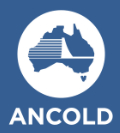Please consider that no extension in these deadlines is foreseen.
| Submission Key Dates |
|---|
| 1 March | Call for Proposals Open |
| 16 April | Call for Proposals Close |
| 20 May | Preliminary Program Announced |
| 29 May | Author Notifications Sent |
| 19 June | Full Papers submissions to be uploaded for review |
| 8 July | 1st Review Complete |
| 7 August | Author to address reviewer comments |
| 9 August | Early Bird Closes (all accepted presenters must now be registered) |
| 26 August | Reviewers to have final comments to author |
| 6 September | Final Paper Submitted for Publication |
| 15 September | Final Program Announced |
We welcome you to submit a proposal to the 2024 ANCOLD Conference! There are three presentation formats on offer at the Conference. You will be able to select a format that will suit you and your presentation.
All authors who have their submission accepted for presentation must register and pay for their attendance, at a minimum, for the day of the Conference on which they are presenting. Accepted presenters will be given access to the Early Bird Registration rates.
1) Oral Presentation
Presentations will be 12-15 minutes. There will also be time for Q&A. Exact time allocation will be provided once submission closes.
2) Rapid Fire Presentation (replacing Posters)
Presentations will be 5 minutes, with a maximum of 5 slides. There will also be 1 minute allocated for Q&A.
3) Published paper only
This submission type allows for an opportunity to supply a written paper for publication in the conference proceedings without having to present the paper.
Submit your proposal (oral presentation, published paper only)
- Log in to the Presentation Portal via the ‘Submit your proposal’ button. You will need to create an online account first – enter your email address and password.
- You will be taken to a screen from which the submission process starts. Please read the instructions on this screen carefully. You will need to update your details before you can submit your abstract.
- Submitting an abstract is a multi-step process. Each step asks several questions. Some questions are marked “required”, and you will not be able to complete your submission until these questions have been answered.
- If you stop part way through the process, your submission will be held in temporary storage until you return and complete all the questions. When you log in again you can click on your incomplete proposal and resume submission.
Make sure that you submit your proposal by agreeing to the Terms and Conditions before pressing the “submit” button, any proposals left in ‘draft’ mode will not be submitted for review. You will receive a confirmation email for each successful abstract submitted. If you do not receive an email, log in again to check your proposal in “Edit Abstract/s”. Please note once you have submitted your abstract you cannot edit it again. However, you can leave your submission in “draft” mode and make changes up until the time you submit it.
Amending a Submission in “draft” mode
You may wish to change your answers to some of the questions on the submission form, or even change the abstract itself.
- Log in to the presentation portal, and click on the “Edit Abstract/s” tab.
- You will see a list of the proposals that you have in draft mode or have submitted. Click on the “Edit” button next to the draft abstract you wish to change and submit.
- Amending an abstract is just the same as for the original submission process, except that the online form will be automatically completed with the answers that you provided previously. You don’t have to change an answer if you do not wish.
- When you reach the final ‘Submit’ step, click on the button stating that you “Agree to the Terms and Conditions” and click “Submit”. If this button is not available, look at the steps on the left-hand table and address the missing information that does not have a tick.
Prior to the Conference
- All presenters must be registered.
- Prepare your PowerPoint presentation in 16:9 aspect ratio.
- Save your presentation to a USB for upload in the Speaker Preparation Room onsite.
- Please do not send your presentation to Leishman Associates prior to the Conference.
At the Conference
- Collect your name badge from the Registration Desk located at the foyer of the convention centre upon arrival.
- Check-in to the Speaker Preparation Room, prior to your scheduled session to ensure your presentation is uploaded and all presenter requirements have been satisfied. Your presentation must be uploaded at least 2 hours before your scheduled presentation time; this may mean the day before your presentation.
- If you have audio and/or video in your presentation, please ensure you have the files saved separately as embedding the media does not always include them in the PowerPoint file. This will allow the Technical Team to re-embed and/or change the format of the video onsite if needed.
- If you are using custom fonts not found in the standard system fonts, please use the “Embed fonts in file” feature found in Save As/tools/save options. This will ensure that your fonts travel with the PowerPoint file when saved.
Please ensure the contents of your presentation including photos, data, graphs etc. are generated by yourself, referenced or the appropriate owner has granted you permission to include their work for educational purposes.
- It’s important to note that presentations cannot be uploaded in the plenary room. It is your responsibility to upload your presentation and check that it has loaded correctly, with the AV Technician in the Speakers’ Preparation prior to the commencement of your session.
Each room will be equipped with the following:
- Data projector
- Screen
- Microphone
- Lectern
- Laser pointer
- Laptop (presenter view)
- Wi-Fi access
If you require anything additional to the above, please email your request to
lucy@laevents.com.au and we will endeavour to meet your request.
During your session
- Arrive in the session room 10 minutes before the start of your session to introduce yourself to the session chair.
- The Session Chair will introduce you and your presentation title, so there is no need for you to repeat this.
- The Session Chair will keep time and will signal to you when you have 1 minute left.
- Each session room is equipped with a windows-based PC, data projection facility and speaker monitor. Be sure to test your presentation in the Speaker Preparation Room.
By submitting a proposal, you agree and understand the following:
• All authors who have their papers accepted for presentation must register and pay for their attendance, at a minimum, for the day of the Conference on which they are presenting. Accepted presenters will be given access to the Early Bird Registration rates. ANCOLD is unable to offer any financial assistance to submitting authors.
• All authors who have submitted have approval to travel and attend the event in person.
• By submitting a proposal, you acknowledge and accept the Key Dates noted above (including first draft paper to be uploaded, revised paper addressing reviewer comments and your Final Paper). Extensions will not be granted beyond these dates
• Authors understand that all papers must be original and must not have been published elsewhere.







